How To Clean Up An Overgrown Herb Garden
Herbs are probably the most popular and intriguing group of plants in existence. Undoubtedly, the explanation for this is that over the centuries herbs have been used in so many different means. They flavour our foods, perfume our homes and bodies, decorate our gardens, and cure our ills. One way or another, herbs bear upon each of our lives.
In this article, we'll show you how to grow an herb garden.
- Preparing Soil for Herb Garden Planting
Count your blessings if you're lucky enough to accept a garden with rich fertile soil, which is deep and easy to work. Good garden soil is not like shooting fish in a barrel to find, and most kickoff gardeners presently realize they must improve on ane or more conditions of the soil. Herbs tin survive in a broad variety of soil types, but by making some simple preparatory changes, your garden soil can become as easy to use and productive as y'all'd similar. Good soil must be guarded by proper management. In this department, we'll teach yous the basics.
- Herb Garden Soil Preparation Techniques
Now that y'all know what you need, you lot're prepare to enroll in the soil-improvement program. In this section, you lot'll acquire how to test your soil for texture and fertility. Then, you'll run across how to improve soil deficiencies. In that location'southward no need to worry if you lot're non satisfied with the results of your testing. Improving your garden soil is hands accomplished and is a regular function of gardening. Remember, all of the soil-improving process doesn't have to happen in the beginning year of gardening. Take time working with your soil, and you'll reap the benefits of many years of fruitful production. Nosotros'll show you how to better your soil, fertilize, and recycle soil to give your herbs the best chance at growth.
- Growing Herbs
Sooner or later on, most of the states decide to endeavour our hand at growing a few favorite herbs. If we oasis't prepared our soil, it usually starts with a pot of parsley on the kitchen windowsill or a short row of dill in the vegetable patch. In one case started, most gardeners discover themselves increasing the number of herbs they cultivate simply considering so many of them flourish with little care. In this section, we'll hash out the best methods to start an herb garden.
- Herb Growing Tips
Similar whatsoever other garden, you have many unlike options for layout and design when planting your herb garden. Do you prefer a container garden close to the kitchen for the aromatic herbs that you beloved to use in your gourmet recipes? Do y'all like rows and rows of lacy anise to sway in the cakewalk on a windy twenty-four hour period? Does a wistful sigh escape your lips every time you pass an intricate knot garden? Would you lot rather plant a mixed garden full of herbs, vegetables, and even edible flowers? In this section, we'll explore the different herb garden options and help you lay out a garden programme to get you ready for planting.
Whether you lot like to cook or similar to consume, null tastes as good equally something you lot've fabricated yourself. Your herb garden will exist a source of fragrant, delicious seasonings for your favorite meals. Permit'south get started by preparing the soil for herb garden planting.
Preparing Soil for Herb Garden Planting
Good soil is the fundamental to an easy-to-maintain garden. While most herbs are pretty hardy and crave little care, you'll all the same find that a piffling preparation goes a long mode.
Improving Your Garden Soil Good soil is 50 percent solids and 50 percent porous space, which provides room for water, air, and establish roots. The solids are inorganic affair (fine rock particles) and organic affair (decaying constitute matter). The inorganic portion of the soil can be divided into three categories based on the size of the particles it contains. Clay has the smallest soil particles; silt has medium-size particles; and sand has the coarsest particles. The amount of clay, silt, and sand in a soil determine its texture. Loam, the ideal garden soil, is a mixture of 20 pct clay, 40 pct silt, and 40 per centum sand.
Some people choose to add vegetables into the herb garden. In the involvement of harvesting a bigger and better crop of herbs and vegetables, you'll want to improve the texture and structure of your soil. This comeback, whether to brand the soil drain meliorate or hold more h2o, tin exist accomplished quite hands past the addition of organic matter.
Organic matter is cloth that was once living but is now expressionless and decaying. Yous tin employ such materials as footing corncobs, sawdust, bark chips, straw, hay, grass clippings, and cover crops to serve as organic matter. Your own compost pile tin supply you with splendid organic matter to enrich the soil.
Each spring, as y'all prepare the garden for planting, incorporate organic thing into the soil past tilling or turning it under with a spade. If noncomposted materials are used, the microorganisms that interruption downwards the materials volition use nitrogen from the soil. To compensate for this nitrogen loss, increase the corporeality of nitrogen fertilizer that you comprise into the soil.
The next footstep in your soil-improvement program is to have the soil tested for food levels. The local county Cooperative Extension office can advise you on testing the soil in your area. Your soil sample volition be sent to a laboratory to decide any deficiencies of the necessary nutrients needed for successful establish growth. Instructions for taking and preparing soil samples tin can be found in our article How to Prepare Soil for Planting. Be sure to tell the laboratory that the samples came from an herb and/or vegetable garden plot. The exam written report will recommend the amount and kind of fertilizer needed for a dwelling garden. Follow the laboratory's recommendations as closely every bit possible during the first growing flavor. We'll talk more than virtually fertilizing below and in the next section, Herb Garden Soil Preparation Techniques. The necessary nutrient levels are relative to the soil type and the crop being grown. Although different herbs take varying requirements, the soil examination institution calculates an optimum average for fertilizer and lime recommendations.
The results of the soil test volition indicate the pH (acid-element of group i balance) of the soil as well as the nitrogen content, phosphorus content, and potassium content. The pH is measured on a scale of 1 (well-nigh acrid or sour) to 14 (well-nigh alkaline or sweetness), with 7 representing neutral. Most vegetable plants produce best in a soil that has a pH between 5.5 and 7.5.
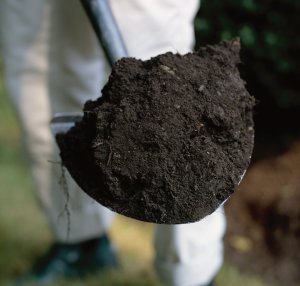
©2006 Publications International, Ltd.
To check your soil texture apace,
squeeze lightly moist soil in your hand.
The pH number is important because it affects the availability of nigh of the essential nutrients in the soil. The soil lab will consider the type of soil you accept, the pH level, and the crops yous intend to produce and make a recommendation for pH adjustment.
Phosphorus (P) and potassium (K) levels will exist indicated by a "Low," "Medium," or "High" level. High is the desired level for herb and vegetable gardens for both nutrients. If your test results show other than High, a recommendation of type and amount of fertilizer volition be made.
Although nitrogen (North) is also needed in large amounts past plants, the soil nitrates level is non usually routinely tested considering rainfall leaches nitrates from the soil, which easily results in low levels. Boosted nitrogen through the use of a complete fertilizer is almost always recommended.
Tests for other elements are available on request but are needed only under special circumstances.
Adjusting Soil pH The soil examination results may propose you to raise the pH past adding a recommended amount of lime to the soil. Ground dolomitic limestone is best and tin can be applied at any time of the year without harm to the plants. You may exist brash to lower the pH by adding a recommended corporeality of a sulfur production. Ammonium sulfate is the sulfur product nigh commonly used. Spread the lime or sulfur evenly through your garden and incorporate it into the soil by turning or tilling.
Fertilizing: How & Why To Do Information technology Many inexperienced gardeners recall that since their herbs have done fine and so far without fertilizer, they'll continue to do fine without fertilizer next yr. But it'southward not quite that simple. Although your plants will probably provide you with herbs without using fertilizer, you won't exist getting their best try. Properly fertilized plants will exist healthier and improve able to resist disease and attacks from pests, providing more and higher-quality herbs.
There are two types of fertilizers: organic and inorganic. Both contain the same nutrients, just their composition and action differ in several means. It makes no difference to the plant whether nutrients come from an organic or an inorganic source every bit long as the nutrients are available. However, the differences betwixt the ii types are worth your consideration.
Organic fertilizers come from plants and animals. The nutrients in organic fertilizers must be broken downwards over a flow of time past microorganisms in the soil before they become available to the plants. Therefore, organic fertilizers don't offer instant solutions to nutrient deficiencies in the soil. Dried blood, kelp, and bone meal are types of organic fertilizers.
Manures are besides organic. They are bulkier and comprise lower percentages of nutrients than other natural fertilizers. However, they offering the advantage of immediately improving the texture of the soil by raising the level of organic matter.
Because organic fertilizers are more often than not not well-counterbalanced in nutrient content, y'all'll probably need to use a mixture of them to ensure a balanced nutrient content. The table below, besides every bit the directions on the bundle, may exist used as a guide to making your own mixture. Incorporate the mixture into the soil while preparing your spring garden. Apply it again as a side-dressing midway through the growing season.
When you fertilize with an inorganic fertilizer, nutrients are immediately available for the plant's use. Any container of fertilizer has three numbers printed on it, such as v-10-20, to indicate the percentage of major nutrients it contains. Nitrogen is represented by the first number (5 percent in this example); phosphorus is represented by the second number (10 percent); and potassium past the tertiary (20 percent). The remaining 65 percent is a mixture of other nutrients and inert filler. A well-balanced complete fertilizer consists of all three major nutrients in somewhat even proportions. A consummate fertilizer is recommended for herb and vegetable garden utilize as long as the nitrogen content isn't more twenty percent. A typical consummate fertilizer used in edible gardens is 10-ten-x.
Analysis of Organic Fertilizers
| Fertilizer | Nitrogen - Phosphorus - Potassium (N-P-G) |
| Stale Claret | thirteen - 1.5 - 0 |
| Kelp | 3 - 22 - 0 |
| Cottonseed Meal | half-dozen - 2.half-dozen - 2 |
| Cattle Manure | 0.5 - 0.iii - 0.five |
| Horse Manure | 0.half-dozen - 0.3 - 0.five |
| Craven Manure | 0.nine - 0.v - 0.8 |
This is only the starting time in our discussion on fertilization. Proceed reading to learn the two-stage program for fertilizing your garden, as well every bit composting and soil recycling.
Herb Garden Soil Preparation Techniques
Across the chemic requirements for fertilization, you also want to make sure that you are supplying the correct nutrients for your herb garden.
Fertilizing Your Garden: A Two-Phase Program
- Circulate Fertilizing.
When you lot're preparing the bed for spring planting, use a complete fertilizer -- such equally 10-10-10 -- evenly to the unabridged garden co-ordinate to the soil test recommendations. Do non overfertilize. A manus spreader helps keep the job neat as it distributes the granules. Plow the fertilizer into the soil with a manus spade or tiller and smoothen out the surface to prepare for planting. This get-go fertilizing step volition see most of your herbs and vegetables through their initial period of growth. Halfway through the growing season, the plants volition accept used up a lot of the nutrients in the soil, and you'll have to replace these nutrients.
- Sidedressing.
As the nutrients are used upwards by the plants, a second boost of fertilizer will be needed to supply the plants with essential elements through the remainder of the growing season. Use the same complete fertilizer at the same rate as used in the spring, simply this time apply it equally a sidedressing to the plants. With a hoe, make a four-inch deep trench forth one side of the row, taking intendance not to disturb the establish'southward roots. Utilize the fertilizer in the trench and then encompass the trench with the soil you removed. Rain and irrigation will work the fertilizer into the soil, becoming available to the plants.
The Gardener'southward Recycling Plan The backyard compost pile is the platonic way to reuse near of your garden and kitchen waste and get benefits galore. Composting is substantially a way of speeding upwardly the natural procedure of decomposition by which organic materials are broken downward and their components returned to the soil. The decaying process happens naturally simply slowly. The proximity, moisture, and air circulation of a compost pile encourages this process. Composting converts plant and other organic wastes into a loose, peatlike humus that provides nutrients to growing plants and increases the soil's ability to control h2o.
Composting can save money you would otherwise spend on soil conditioners and fertilizer. Information technology can salvage time, also, since it gives you lot a identify to dispose of grass clippings, weeds, and other garden debris.
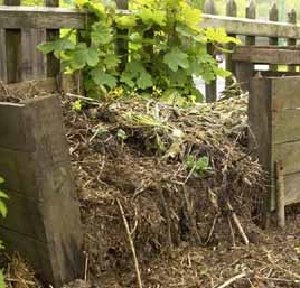
©2006 Publications International, Ltd.
This compost pile serves many uses in the vegetable garden.
Garden waste material can be turned into good compost in less than a twelvemonth if the pile is properly managed. When the compost is ready -- coarse, nighttime chocolate-brown, peatlike material -- it tin be used for many purposes. Compost tin be added to potting soil for starting garden seeds indoors. It tin also be used as a mulch to protect a plant's roots from the hot, dry summer sun. Compost is also an splendid cloth to incorporate into garden soil to help control moisture: either increasing the water-holding capacity in sandy soils or improving drainage in heavy clay soils. The more organic matter you add, the more you amend the texture of the soil. Blend the compost into the soil to a depth of 12 inches, making certain information technology is evenly dispersed through the entire planting area. When compost is added to the soil, it will absorb some of the soil's nitrogen. To compensate for this, organic or inorganic fertilizer and work it into the soil with the compost.
Except for diseased and pest-laden materials or materials that have been treated with herbicides, almost any type of garden waste product can be composted. You can too use such kitchen leftovers as vegetable and fruit peels, vegetable tops, coffee grounds, tea leaves, and eggshells. Don't use meat products or greasy foods, which tend to aroma bad and concenter animals. Composting textile should exist kept moist but not soggy, and it should be supplied with a nitrogen fertilizer (manure, dried blood, bone meal, or commercial fertilizer) to keep the microorganisms agile for faster decay.
Compost forms every bit organic wastes are broken downwards by microorganisms in the soil. These microorganisms don't create nutrients; they just break downwards complex materials into simple ones that the constitute can use. Soil microorganisms are about active when soil temperatures are to a higher place 60 degrees Fahrenheit, and most of them piece of work best in a moist, slightly element of group i environs. Microorganisms work fastest on small pieces of organic fabric.
There are two basic types of microorganisms: those that need air to piece of work (aerobic) and those that don't need air (anaerobic). It's possible to compost in an airtight container, thanks to the microorganisms that don't demand air. A tightly covered plastic trash can volition catechumen an enormous corporeality of organic kitchen waste into compost in the course of a winter. The classic outdoor compost pile should be turned regularly (near once every two weeks) with a pitchfork to provide air for the microorganisms that need it.
At that place are several handy composting devices on the market place. Each has its own advantages, but a compost pile need not be fancy to work well. A simple bin fabricated with quondam cinder blocks, lumber, or fencing textile can be used. Tucked aside, only not too far from the garden, the bin can be square, rectangular, or round. It should exist four to five anxiety across and well-nigh three feet high.
There are almost every bit many different methods of composting as at that place are gardeners. Follow these basic steps of composting to be a success.
How to Beginning a Compost Pile
- Start with either a one- to ii-foot pile of leaves or half dozen to 12 inches or more than of compact material, such as grass clippings or sawdust. You can compost hay, straw, hulls, nutshells, and tree trimmings (except walnut). Nonetheless, unless they're shredded, they'll accept a long time to decompose. Use any organic garden or kitchen waste (except meat scraps), as long equally information technology contains no pesticides or diseases.
- Over this initial pile spread a layer of fertilizer. The nitrogen will help activate the microorganisms, which in turn will speed the decay of the organic materials. Add about 1/2 cup of ground limestone (about microorganisms like their environment sweetness). Then add together several shovelfuls of garden soil, which volition provide a starter colony of microorganisms. It's handy to have a modest pile of soil nearby when you start the compost pile.
- Water the pile well. The pile should exist kept moist, like a squeezed sponge. Keep adding garden waste to the top of the pile equally it becomes bachelor. As the layers get thickened and compacted, repeat the layers of fertilizer, lime, and soil.
- About once every 2 weeks, turn and mix the pile with a pitch fork or digging fork. This will ensure that all the components of the pile, not just the center, volition heat upward. Every bit the temperature in the compost pile increases, weed seeds and harmful disease organisms are killed, and the disuse process will not be delayed.
At present that your soil is set up for your herbs, let's talk about how to establish and grow herbs.
Learning How to Grow Herbs
Herbs are useful for cooking, crafting, and decorating -- boldly coming out of the garden and into your home. A separate herb garden is wonderful, but herbs tin also be blended with flowers and vegetables in a kitchen or a cottage garden. You lot tin also slip herbs in bloom or shrub beds, or even into the plantings around your foundation.
Culinary herbs are a mainstay of most herb gardens. The garden-fresh flavors of thyme, basil, savory, oregano, and marjoram are incomparable. You can also grow gourmet varieties of these classics -- lemon thyme, cinnamon basil, and Sicilian oregano, for instance -- to add to your cooking pleasure.
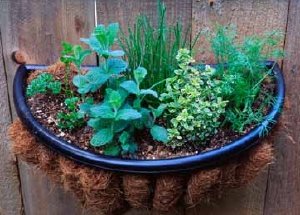
©2006 Publications International, Ltd.
If you don't take the infinite for a split herb garden,
consider growing a pick of herbs in a container.
Program an herb garden before you plant. Some of the most charming herb gardens have formal beds or geometric patterns that evidence off the beauty of herbal leaf. Hither are some examples:
- Knot gardens interweave herbs with contrasting leafage colour and textures into uncomplicated or intricate patterns, many of which are taken from embroidery schemes. Simple knot gardens can be made with two overlapping circles or squares set up on a groundwork of mulch or gravel. An easy style to make a knot is with almanac herbs such as bush-league basil, summer savory, or sweet marjoram, or even almanac flowers such equally French marigolds or ageratum.
- Formal herb gardens more often than not have symmetrical planting plans, with matched herbs on either side of the garden like reflections in a mirror.
- Formal and patterned herb gardens often include neat, clipped edgings of boxwood, teucrium, santolina, thyme, winter savory, or other neat herbs suitable for shearing. We'll talk more about planting plans in the next section, Herb Growing Tips .
Provide sandy soil for herbs that demand well-drained soil of moderate fertility. If kept in soil that'south lean and light and drenched in hot sun, these herbs develop splendid flavor.
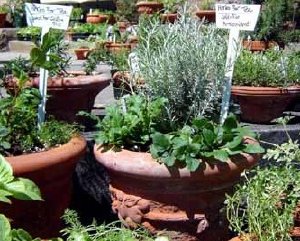
©2006 Publications International, Ltd.
Grow herbs that need low-cal soil in pots.
- If your soil is naturally sandy and well drained, you're in luck. If, instead, information technology'south clammy dirt, raise the herb garden and add a 3-inch layer of coarse sand and 2 inches of compost to improve drainage. Avert excessive apply of fertilizers, particularly those high in nitrogen.
- Grow herbs that demand light soil in pots. When planted in well-drained, peat-based potting mix, herbs such as thyme, lavender, and rosemary thrive -- and they look nifty.
Plant perennials that double as herbs in blossom beds and borders. Some herbs masquerade as perennials (and vice versa) because they can exist used for decorating, fragrance, or cuisine. Some examples include the post-obit:
- Sweetly fragrant bee lotion has flowers and foliage wonderful for tea or drying for potpourri.
- Yarrow bears everlasting flowers for stale floral arrangements. Air drying is fine for golden-flowered forms. To preserve the color of pinkish, red, and white-flowered yarrows, dry out them in silica gel.
- Lady's drape is a historical herb with lovely scalloped leaves and small sprays of yellowish-dark-green flowers for cutting.
- Pinks have fragrant flowers that tin exist used fresh for cutting-flower arrangements or stale for potpourri.
- Use herbs with attractive leaf for flavor-long colour in perennial gardens. Amidst the comings and goings of perennial flowers, neatly or colorfully clad herbs maintain indelible style and beauty.
- Some of the best herbs to grow for decorative leaf include globe basil (pocket-size mounds of emerald green), bronze leaf basil or perilla, ornamental sages (with purple leaves, variegated gold leaves, or tricolor light-green, white, and pink leaves), and silver-leaved herbs such every bit gray santolina and lavender.
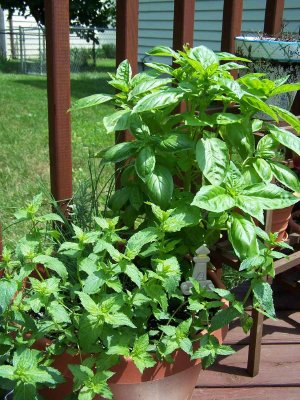
©2006 Publications International, Ltd.
Plant unremarkably used culinary herbs in a clay planter
nigh a sunny kitchen window for convenience.
- For a great overall color scheme, complement the color of the foliage with nearby flowers.
- Institute a collection of commonly used culinary herbs in a clay planter by a sunny kitchen window. They volition be right at paw when you need them.
- Restrain rampant herbs like mint and bee balm so they tin can't take over the garden. These plants need house limits to keep them in their proper place.
- Plant rampant herbs in large plastic pots with the lesser removed and the height rim emerging an inch or ii higher up the soil surface. The container volition slow down spreading growth enough then you can encounter trouble before it spills over the edge. Cut back whatever errant sprouts and use them for tea or to garnish a fruit salad. Separate to renew the chastised establish every twelvemonth or two.
- Pinch back almanac herbs, such equally basil, to keep them from blooming. If allowed to channel energy into seed production, the leafage will abound skimpy and so will your harvest. Pinching off the shoot tips from time to time provides sprigs for herbal vinegars and pestos and inspires the plant to grow back bushier than ever.
- Remove a few bricks in a garden path to make places for depression-growing thyme or oregano. Either herb will thrive in this warm, well-drained location and will give a charming natural look and wonderful fragrance to the walkway.
- Plant more parsley, dill, and fennel than yous retrieve you will use to attract swallowtail collywobbles. The beauty of the butterflies and fun of watching the caterpillars develop can be worth the leaf they eat.
- Harvest perennial herbs every bit they develop flower buds. This is the time when the fragrant and flavorful oils in the plants are at their peak of intensity, providing a gourmet experience. Because fresh herbs taste so expert, fifty-fifty at other times of the growing season, it's perfectly acceptable to continue harvesting whenever you feel the urge. In cold climates, nevertheless, hardy perennial herbs need a break from heavy harvesting beginning 45 days before the starting time frost in order to prepare for wintertime.
Herbs fit beautifully into whatever mural. In the next department, we'll discuss how to plan formal and breezy herb garden designs, as well as look at what how to harvest your herbs.
Herb Growing Tips
Ground-hugging thyme is a perfect choice for planting betwixt the rocks in a flagstone walk. Tall clumps of angelica or rue provide attractive and dramatic accents in flower borders. Nasturtiums and chives add outstanding floral color to a garden, also as making attractive cut flowers. The purple-leaf variety of basil is an center-communicable accent in any location. No matter which type of herb you adopt, we can aid y'all design the right program for your herb garden.
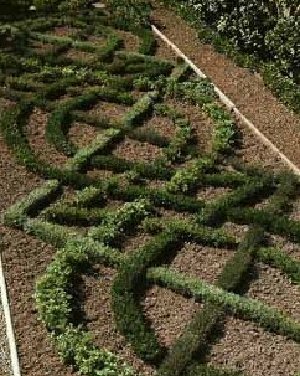
©2006 Publications International, Ltd.
This intricate knot garden combines fragrant herbs and shrubs.
Although herbs are often planted in a formal layout separate from the residue of the garden, this is by no means a requirement for success in growing them. Herbs can be mixed into other plantings. The exceptions are those few herbs, such as mint, that will aggressively take over if non curbed. These are best planted in containers or separate beds, where strict command of their spread can be maintained. About other herbs can be planted along with other row crops in your vegetable garden. Herbs tin can be laid out in a very formal or an extremely informal design or anywhere in between. The pick is entirely up to your personal view regarding what will fit best with adjacent garden spaces. When planning a vegetable garden that includes herbs, the same bones rules of good design apply as when designing whatever other garden. Tall plants should exist located at the rear of side beds, plants of intermediate height in the heart of the bed, and low-growing plants at the forepart. This fashion they'll all obtain a maximum share of the available light. In fundamental beds, the tallest plants can exist located in the center of the bed, the shortest plants around the outer edge, and the intermediate heights between the ii. The best arroyo to deciding which herbs to abound is to make a list of herbs you're near likely to apply. Write downwardly their soil, light, and h2o needs; their height and spread; and any special notes such as unusual growth habit. Make a secondary list of plants you might relish having if there's any room left. Sketch the herb garden area to scale (for example, 1 inch on the sketch equals one human foot on the ground), decide on the size and shape of the planting beds, and decide which of the herbs on your list will be located where. Fill up in whatever empty spots with appropriate species from your secondary list.
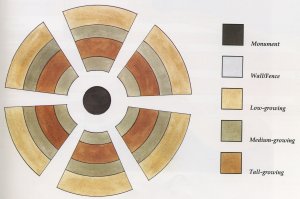
©2006 Publications International, Ltd.
This formal herb garden layout centers around a monument.
All paths and attention atomic number 82 to this feature, whether it'due south in the center of the garden or along one edge. Breezy Herb Garden Layouts Here are two informal layouts. One backs a wall or fence and the other stands as an island in the eye of a backyard area.
Blue = Monument
Grey = Wall / Contend
Beige = Depression-growing herbs
Greenish = Medium-growing herbs
Brown = Alpine-growing herbs
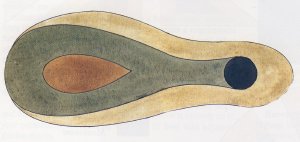
©2006 Publications International, Ltd.
This breezy layout stands as an isle.
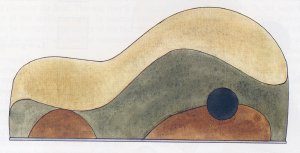
©2006 Publications International, Ltd.
This breezy layout backs against a contend.
Harvesting As a full general rule of thumb, herbs have the highest level of flavour in their leaves only before they flower. Harvesting is best washed at this time. In the directory of vegetable and herb plants, you'll discover notes regarding the all-time time to harvest each herb equally well as the best methods of preservation. When harvesting herbs to preserve for futurity utilize, wait until the plant is at its aromatic peak as noted in the directory. Pick it early in the morning when aromatics are at their highest level of the day. Discard any diseased or insect-infested portions. If there is dust present, wash the institute thoroughly and milk shake off as much of the excess water as possible before processing. If possible, wash the plant a day before harvesting. Be especially careful when harvesting seeds. The timing must exist precise enough to allow the seeds to ripen completely, but they must be caught before they disperse. One way to solve this problem is to continue watch on a daily basis and harvest every bit before long as the seeds begin to dry. Carefully snip off the heads over a large paper bag, assuasive the seeds to fall directly into the bag. Keep them in the pocketbook to complete the drying procedure. Exist careful not to compact the seed heads; air circulation in and around the seed heads is needed to cut down on the possibility of the growth of undesirable molds. If you lot cannot go along such shut runway of the maturation process, another alternative is to enclose each seed head while however on the plant in a minor paper or mesh bag in one case all flowering has concluded and the greenish seeds become obvious. And then, when the heads dry, any seeds that fall out volition be captured in the bag. Once y'all notice that seeds are beingness released, snip off the heads, purse and all, and dry them indoors. The most common method of herb preservation is past hang drying. Another practiced way to preserve many herbs is past freezing them. This method is quick and piece of cake, and the flavor is usually closer to fresh than dried. If you have the freezer space available, freezing is probably the well-nigh desirable option for cooking herbs. Some herbs lose flavour when exposed to air, but they will retain information technology if stored in oil or liquor. Some herbs don't retain as much flavor when preserved by whatever ways -- they tin can only be used fresh. You lot can, however, extend their flavour past growing them indoors as pot plants during the wintertime months. Herb Chart
Harvesting of herbs for fresh use can be done throughout the growing season. Thyme, sage, rosemary, and many other perennials need their agile growing shoots snipped in 4- to 6-inch lengths. For annuals collect a few leaves as needed.
Cardinal:
Plant: A= Almanac, B= Biennial, P= Perennial
Lite: FS= Total Dominicus, PS= Partial Shade, Southward= Shade
Soil: P= Poor, A= Average, R= Rich, Southward= Sandy, Chiliad= Moist, D= Dry
Civilisation: Due east= Easy to Abound, A= Average, D= Difficult, R= Rampant Grower/ Keep Restricted
Height and Spread is in inches.
| Proper noun | Plant | Landscape | Lite | Soil | Height | Spread | Culture |
| Angelica | B | | FS, PS | A, One thousand | 60-72 | 36 | E |
| Anise | A | | FS | A, D | xviii-24 | 4-8 | Eastward |
| Basil | A | | FS | R, Thousand | 18 | 10 | Eastward |
| Chervil | A | | PS | A, M | 18 | 4-8 | A-D |
| Chives | P | | FS, PS | A-R, K | 8-12 | 8 | E |
| Coriander | A | | FS | R | 24-36 | half dozen | E |
| Costmary | P | | FS, PS | R | 30-36 | 24 | East |
| Dill | A | | FS | A-S, Grand | 24-36 | half dozen | Due east |
| Fennel | P | | FS | R | l-72 | 18-36 | Eastward |
| Garlic | P | | FS | A-P | 18 | 8 | E |
| Geraniums, scented | P | | FS | A-R | Varies | Varies | A |
| Horehound | P | | FS | A-P | xxx | 12 | E |
| Marjoram | P, A | | FS | R | 8-12 | 12-18 | East |
| Nasturtium | A | | FS, PS | A-P, Thou | 12-72 | eighteen | Due east |
| Oregano | P | | FS | A-Due south | 18 | 12 | E |
| Parsley | B | | FS, PS | R, Thousand | 12 | 8 | E |
| Peppermint | P | | FS, PS | R, M | 24-xxx | 12 | E, R |
| Rosemary | P | | FS | S | 48-72 | 18-24 | A |
| Rue | P | | FS | P, S | 24 | 18 | A |
| Sage | P | | FS | S | 20 | 24 | Eastward |
| Savory, Summertime | A | | FS | R-A | 18 | 8 | Due east |
| Sorrel, French | P | | FS, PS | R, Thousand | 18 | 10 | E |
| Southernwood | P | | FS | Whatsoever | 30 | 24 | East |
| Spearmint | P | | FS, PS | R, M | xx | 12 | Eastward, R |
| Sweet, Woodruff | P | | South | R, M | 6-8 | half dozen-eight | D |
| Tansy | P | | FS, PS | A-P | forty | 12-18 | E, R |
| Tarragon, French | P | | FS, PS | South-R | 24 | 24 | A |
| Thyme | P | | FS, PS | P-A | 1-10 | 12-18 | E, R |
| Wormwood | P | | FS | Any | thirty-48 | xv-20 | A |
There are so many different varieties of herbs that nosotros can't begin to depict them all. Instead nosotros've chosen a few of the tried and true varieties to help you as start to abound your herb garden. © Publications International, Ltd.
Source: https://home.howstuffworks.com/how-to-grow-an-herb-garden.htm
Posted by: phillipspritioneatch.blogspot.com


0 Response to "How To Clean Up An Overgrown Herb Garden"
Post a Comment